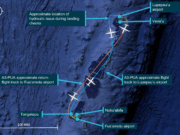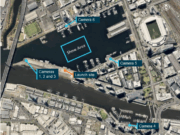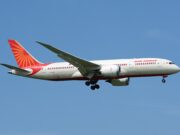
The following information provides an awareness of problems that might be avoided in the future. The information is based on final reports by official investigative authorities on aircraft accidents and incidents.

Jets
Bird Hit Gear Door
Boeing 747-400ER. Minor damage. No injuries.
A training captain occupying the right seat noticed a loud, strange sound as the aircraft neared cruise altitude after departing from San Francisco the night of Oct. 6, 2016, for a flight to Sydney, Australia. The trainee captain, who was new to the aircraft, did not notice anything unusual, and the cockpit instruments showed no sign of anything amiss.
Shortly thereafter, the cabin services manager (CSM) told the flight crew that an abnormal vibration and a louder-than-usual noise had been detected near the left overwing cabin door. The second officer was sent to the cabin to investigate. “The second officer inspected several sections of the cabin in consultation with the CSM and other flight attendants,” said the report by the Australian Transport Safety Bureau (ATSB). The second officer confirmed the unusual noise and vibration near the overwing exit, and suspected that they might be associated with a right main landing gear door seal. He returned to the cockpit and briefed the other pilots on what he had found.
“Unlike other large passenger aircraft, [the incident aircraft] did not have installed video cameras that permitted the crew to view external parts of the aircraft,” the report said. “In any event, the night conditions may have hampered visual examination of the landing gear area on this occasion.”
There were no checklists to guide the crew in troubleshooting the situation. They relayed relevant information by satellite phone to the airline’s maintenance operational control center (MOC). “The flight crew, in consultation with the MOC duty manager and the cabin crew, then systematically went through a process of trying to isolate the source of the vibration/noise,” the report said. “The troubleshooting was unable to isolate the source of the vibration and noise. The flight crew requested that the cabin crew continue to monitor the vibration/noise and to advise them of any change. As the aircraft was otherwise performing normally, the flight was continued.”
No change in the vibration or noise was detected, and the flight crew, who had considered diverting to Honolulu, decided to continue the flight to Sydney. “The CMS reported that the vibration and noise persisted up until the landing gear was extended during the approach to Sydney,” the report said. After an uneventful landing, an examination of the aircraft revealed a protruding landing gear seal and a broken door actuator rod (door strut). No other damage was found. After the seal and actuator were replaced, the aircraft was returned to service.
“The ATSB found that during departure from San Francisco International Airport, and unbeknown to the flight crew, the aircraft sustained impact damage from a bird strike,” the report said. “The bird strike sheared a landing gear door strut, resulting in the door not closing. That, in turn, led to turbulent airflow and in-cabin vibration.”
The report included the following message: “This occurrence highlights that even with the assistance of sophisticated technology and systems, flight crew may experience situations that can only be managed using their professional judgement. In this case, the fight crew utilised the support of both on-ground maintenance personnel and cabin crew to methodically troubleshoot the source of the vibration and assess that the flight could be safely continued to the destination airport.”
Incursion By Customs Vehicle
Fokker F28-100. No damage. No injuries.
A vehicle with four customs inspectors aboard was being driven on the northern perimeter road at Perth (Australia) Airport the morning of Oct. 19, 2016. The destination was the international apron, where a departing aircraft requiring a customs inspection was supposed to be located. “When the vehicle arrived at the international apron, the aircraft was not there, so the driver decided to show the other passengers some different areas of the airport while they waited for the aircraft to arrive,” said the ATSB report. The driver apparently decided to show his passengers the domestic apron, an area of the airport with which he was unfamiliar.
Rather than proceeding along an authorized route to the domestic apron, he inadvertently entered the airport maneuvering area and proceeded south along several taxiways. “The driver entered the taxiways without a clearance and without having authorisation to do so,” the report said, noting that the vehicle was not equipped with a transponder or a radio.
The driver eventually saw the aircraft that they were supposed to inspect and drove toward it. The report said that the aircraft was being towed in company with two safety vehicles and was awaiting clearance to cross the active runway, Runway 21, near the approach threshold. A senior airport operations officer saw the vehicle and radioed the surface movement controller to learn its identity. The controller said that he assumed the vehicle was associated with construction under way on taxiways farther south along the runway.
Meanwhile, the airport traffic control tower had cleared the towing crew to proceed across Runway 21. A few moments later, the flight crew of an inbound Fokker F28 was cleared to land.
A construction supervisor saw the customs vehicle on the taxiway leading to Runway 21 and pursued it in his safety vehicle. The supervisor pulled up behind the customs vehicle and used his siren and horn to signal the driver to stop. By then, the customs vehicle had crossed the holding point for Runway 21. The construction supervisor used a loudspeaker to inform the customs vehicle driver that he was about to enter an active runway.
The customs vehicle driver made a hard right turn and drove back across the runway holding point. The F28 passed by on the runway about three seconds later; the flight crew had not seen the vehicle before landing.
Ice Blocks Fuel Filters
Cessna CitationJet. No damage. No injuries.
The flight from Barcelona, Spain, to Manchester, England, with four passengers progressed normally until the aircraft neared the English Channel at Flight Level 400 (approximately 40,000 ft) the afternoon of Oct. 31, 2013. The flight crew noticed a fuel imbalance of 120 lb (54 kg) and transferred fuel from the right tank to the left tank until the quantities matched.
About 10 minutes later, the crew received a warning that fuel was bypassing the right engine’s fuel filter. “The flight crew consulted their quick reference handbook (QRH), which advised that a landing should be made ‘as soon as practical’ and that the crew should consider the possibility of partial or total loss of thrust from both engines,” said the report by the U.K. Air Accidents Investigation Branch (AAIB). “As the aircraft was nearing its destination, the crew elected to continue the flight to Manchester.”
Shortly thereafter, however, the pilots received a warning that fuel also was bypassing the left engine’s fuel filter. “The flight crew informed ATC [air traffic control] of the situation and requested diversion to a suitable airport,” the report said. “London Gatwick was offered, which the crew accepted.”
The CitationJet was landed at Gatwick with no further incident. Investigators determined that the fuel filters likely had been obstructed by ice due to an insufficient amount of anti-icing fuel additive. “Fuel is not heated before it reaches the engine fuel filters [in the CitationJet], and therefore an anti-icing additive must be mixed with the fuel to prevent fuel icing,” the report said.
The commander told investigators that the aircraft had been refueled in Barcelona with 1,947 lb (883 kg) of Jet-A that did not contain anti-icing additive, bringing the total fuel quantity to 2,700 lb (1,225 kg). Although a supply of anti-icing additive normally is carried aboard the aircraft, there was an insufficient quantity for the uploaded fuel. “Consequently, the commander inadvertently added only half the required amount of additive,” said the report, noting that the ram air temperature at the CitationJet’s cruise altitude was minus 48 degrees C (minus 54 degrees F).
 Turboprops
Turboprops
Shortcut Leads to High Terrain
DeHavilland Canada Twin Otter. Destroyed. Ten fatalities.
The Twin Otter was on a scheduled flight from Masamba, Indonesia, to Makassar the afternoon of Oct. 2, 2015. Shortly after reaching cruise altitude, 8,000 ft, the flight crew decided to deviate from the planned visual flight rules route and proceed to a waypoint that was on a more direct course to the destination.
The decision was made without considering the risks of encountering higher terrain and instrument meteorological conditions, said the report by the Indonesian National Transportation Safety Committee.
A search was initiated after the aircraft did not arrive on schedule at Makassar. No emergency locator transmitter signal was detected, and the wreckage was not found for three days. Investigators determined that the Twin Otter had struck a mountaintop shrouded by clouds about 14 minutes after the crew initiated the deviation from the planned route. “All occupants were fatally injured, and the aircraft was destroyed by impact force and post-impact fire,” the report said.
Gearbox Retainer Fails
Fairchild Metroliner. Minor damage. No injuries.
The Metro was on a scheduled flight with 13 passengers from Armidale, New South Wales, Australia, to Brisbane, Queensland, the morning of Oct. 12, 2016, when it suddenly yawed right while cruising at 17,000 ft. “The flight crew then employed their ‘identify and confirm’ crew resource management procedures to confirm the right engine was not delivering power and then shut down the right engine and feathered the right propeller,” the ATSB report said. “During the diagnosis, the PM [pilot monitoring] noted that all right engine indications were normal except for a low torque reading (10 percent) and a low fuel flow (140 pounds [64 kg] per hour).”
The crew decided to continue the flight to Brisbane. The PM declared an urgency, reporting that the aircraft was descending due to an engine failure, and requested and received clearance to proceed directly to the airport. The Metro subsequently was landed without further incident.
The operator’s maintenance staff found that a retainer ring in the engine accessory gear assembly had failed, allowing the main (propeller) shaft to disengage from the engine-driven reduction gearbox. The report noted that the engine had been operated 2,429 hours after it was overhauled in 2009. The overhaul included installation of a new retainer ring. “The failure of the retainer ring [occurred] within the required gearbox inspection intervals and without prior warning of an impending failure,” the report said.
Side-Slip Leads to Flameout
Socata TBM-700. Substantial damage. One serious injury.
The single-turboprop was in cruise flight at 6,000 ft the afternoon of Oct. 5, 2014, when the engine flamed out. The pilot shut down the engine and feathered the propeller. He did not attempt to restart the engine. “An air traffic controller provided vectors toward a local airport [Falcon Field in Peachtree City, Georgia, U.S.]; however, the pilot reported that the airplane would not reach the runway,” said the report by the U.S. National Transportation Safety Board (NTSB).
The pilot attempted to land the TBM, with the landing gear and flaps retracted, on a sports field in Fayetteville, Georgia. “The airplane collided with trees and the ground, and then came to rest upright,” the report said. The pilot sustained minor injuries, and his passenger was seriously injured.
Examination of the airplane revealed no mechanical anomalies or malfunctions that could have caused the power loss. The investigation concluded that the pilot likely inadvertently disengaged the yaw damper while flying the airplane on autopilot and did not notice the resulting side-slip, which caused the selected fuel tank to unport and the engine to flame out due to fuel starvation.
“Although the [TBM-700’s] fuel tank system was designed to prevent unporting of the fuel lines during momentary periods of uncoordinated flight, it was not intended to do so for extended periods of uncoordinated flight,” the report said. “If the pilot had recognized the side-slip condition, he could have returned to coordinated flight and prevented the engine power loss. Also, once the airplane returned to coordinated flight, an engine restart would have been possible.”
Impairment Suspected in Control Loss
Beech King Air B200. Destroyed. Two fatalities.
An early morning departure for a business flight from Stapleford Aerodrome in Epping Forest, England, on Oct. 3, 2015, was postponed by the pilot due to visibility estimated at 600 m (3/8 mi). About an hour later, the pilot estimated that visibility had improved to 1,000 m (5/8 mi) and was suitable for departure, the AAIB report said.
Witnesses lost sight of the King Air shortly after it lifted off the runway. Recorded ATC radar data showed that the airplane began to turn right after climbing about 655 ft and then began to descend. “The descent continued until the aircraft struck some trees at the edge of a field, approximately 1.8 nm [3.3 km] southwest of the aerodrome,” the report said. The pilot and his passenger were killed.
Examination of the aircraft revealed nothing that might have caused the control loss. “The post-mortem examination of the [40-year-old] pilot found evidence of an acute dissection of a coronary artery, the presence of which indicated that he might have suffered symptoms ranging from impaired consciousness to sudden death,” the report said. “Acute dissection of a coronary artery is a rare event which can occur spontaneously and is difficult to predict through medical examinations or ECGs [electrocardiographs].”
 Piston Airplanes
Piston Airplanes
Disoriented During Approach
Cessna 340A. Destroyed. Four fatalities.
The airplane was en route the morning of Oct. 10, 2013, from Fort Lauderdale, Florida, U.S., to Hampton Roads, Virginia, which had 3 mi (4,800 m) visibility and a 400-ft ceiling. The pilot was cleared to conduct a global positioning system (GPS) approach.
ATC radar data indicated that the airplane deviated as much as 6 nm (11 km) off course and crossed the final approach fix 400 ft too low. The pilot initiated a missed approach upon reaching the minimum descent altitude but did not follow the published procedure. “The airplane flew southeast [rather than southwest] and ascended and descended several times before leveling off at 2,800 ft,” the NTSB report said. “The airplane then entered a right 360-degree turn and almost completed another circle before it descended into terrain.” The pilot and his three passengers were killed.
GPS navigation equipment had been installed in the 340 six months earlier. The investigation concluded that the pilot likely was not familiar with or was not proficient in the use of the equipment and had lost control of the airplane due to spatial disorientation.
Crankshaft Fractures on Takeoff
Cessna 421B. Destroyed. Two fatalities.
Shortly after the 421 lifted off Runway 31 at Hammond, Louisiana, U.S., the afternoon of Oct. 14, 2015, a witness heard a loud pop and saw the right propeller’s rotation slow. “The witness reported that the airplane yawed to the right and then began a right turn toward Runway 18 with the right engine’s propeller windmilling,” the NTSB report said. “The airplane cleared a tree line by about 150 ft, rolled right, descended straight down to ground impact and burst into flames.”
Examination of the right engine revealed that the crankshaft had fractured. Investigators determined that maintenance technicians had not properly tightened the crankcase through-studs when the cylinders were replaced during an annual inspection eight months earlier. “Also causal were the pilot’s failure to feather the propeller on the right engine and his failure to maintain control … while maneuvering to return to the airport,” the report said.
 Helicopters
Helicopters
Turbulence Causes Mast-Bumping
Robinson R44. Destroyed. One fatality.
High winds and turbulence were forecast for the route from Karamea, New Zealand, to Nelson, where the pilot was ferrying the R44 for scheduled maintenance the morning of Oct. 7, 2014. About 30 minutes after departing from Karamea, one of the main rotor blades struck the cabin, and the main rotor assembly separated from the helicopter, which then descended into dense bush in Kahurangi National Park.
“The cause of the main rotor strike and subsequent separation was a phenomenon associated with helicopters having two-bladed, semi-rigid teetering main rotor systems, called ‘mast-bumping,’” said the report by the New Zealand Transport Accident Investigation Commission (TAIC). “Mast-bumping is where an excessive teetering or ‘see-saw’ movement of the main rotor causes the inner end (spindle) of the blades to contact the main rotor driveshaft (or mast) while rotating.”
The report said that the mast-bumping likely was initiated by turbulence, high winds and severe downdrafts that induced a negative load factor on the helicopter. However, the report also noted that “the commission could not rule out a flight control input as having contributed to the in-flight break-up.”
The report noted that the pilot had 65 flight hours in helicopters and 11 hours in R44s. The U.S. Federal Aviation Administration issued airworthiness directives in 1995 that, in part, prohibit the R44 and the smaller R22 helicopter from being flown by pilots with fewer than 200 flight hours in helicopters or fewer than 50 hours in Robinsons when wind velocity exceeds 25 kt or in moderate, severe or extreme turbulence. “The flight manual limitations were later removed from the R44, as it was deemed to be a more stable design than the R22,” the report said.
Based on these findings, the TAIC recommended that the limitations and requirements applicable to R22 pilots be extended to all R22, R44 and R66 pilots “regardless of their experience levels.”
Tie-Down Strap Overlooked
Bell 206B. Substantial. One serious injury.
The JetRanger had been towed on a helicopter transport trailer to a remote agricultural application work site near Atlanta, Arkansas, U.S., the morning of Oct. 3, 2014. The helicopter had been secured to the trailer with four heavy-duty ratchet-type tie-down straps.
“After arrival at the work location, the pilot and several ground crewmembers prepared the helicopter for flight,” the NTSB report said. “The pilot reported that during his walk-around inspection prior to the flight, he had overlooked the right rear tie-down.” When he subsequently applied power for takeoff, the JetRanger rolled right and struck the ground. The pilot was seriously injured.
“The characteristics displayed by the helicopter were indicative of it encountering a dynamic rollover,” the report said. “The helicopter sustained substantial damage to the main rotor system, transmission, tail rotor, tail boom and fuselage.”
| Date | Location | Aircraft Type | Aircraft Damage | Injuries |
|---|---|---|---|---|
|
NA = not available This information, gathered from various government and media sources, is subject to change as the investigations of the accidents and incidents are completed. |
||||
| Aug. 2 | Cloncurry, Australia | Robinson R22 | destroyed | 1 fatal |
| The helicopter struck terrain after colliding with power lines during cruise flight. | ||||
| Aug. 3 | Medan, Indonesia | Boeing 737-900, ATR 72-500 | substantial | 223 NA |
| No injuries were reported when the 737 struck the ATR while landing. The 737’s left wing struck the right wing of the ATR, which was lining up for takeoff on the runway. | ||||
| Aug. 3 | Delta Junction, Alaska, U.S. | Airbus AS350 | substantial | 2 none |
| The helicopter was being landed at a remote drilling site surrounded by trees when two main rotor blades struck drilling equipment. | ||||
| Aug. 3 | Solomon, Alaska, U.S. | Robinson R44 | substantial | 2 none |
| The helicopter sank after striking the water while dropping mineral claim markers on the surface of a lagoon. | ||||
| Aug. 4 | Mulino, Oregon, U.S. | Cessna 208B | substantial | 1 NA |
| No injuries were reported when the Caravan’s nose landing gear collapsed while returning from a parachuting flight. | ||||
| Aug. 5 | Pocatello, Idaho, U.S. | Lockheed P2V-5 | substantial | 3 none |
| The flight crew was able to return to the airport and land without further incident after they lost pitch control shortly after departing on a fire-fighting mission. Examination of the airplane revealed that a bolt that had not been safety-wired had backed out of the drive coupling for the varicam, which is connected to the Neptune’s elevators. | ||||
| Aug. 7 | Meekatharra, Australia | Pilatus PC-12 | NA | 1 none |
| Shortly after departing on an aerial work flight, oil began streaming across the windshield. The pilot returned to the airport and landed the PC-12 without further incident. | ||||
| Aug. 10 | Villa Grove, Colorado, U.S. | Hughes 500 | substantial | 1 serious |
| The helicopter was involved in an external load operation in high winds when the tail rotor struck a power line. | ||||
| Aug. 11 | Greenwood, Mississippi, U.S. | Piper Cheyenne | minor | 1 none |
| The landing gear warning horn sounded on departure, and the autopilot engaged while the pilot was returning to the airport for a precautionary landing. The pilot was unable to silence the horn and tried for several hours to disengage the autopilot. Using variable thrust, he eventually was able to land the airplane without further incident. | ||||
| Aug. 12 | Charlottesville, Virginia, U.S. | Bell 407 | destroyed | 2 fatal |
| The police helicopter was on a surveillance flight when it entered a steep descending turn and struck trees and terrain. | ||||
| Aug. 14 | Zemyo, Japan | Socata TBM-700 | destroyed | 2 fatal |
| Shortly after departing from Yao Airport, the pilot reported an “unexpected situation” and requested clearance to return to the airport. The TBM then entered a spin and crashed in a densely wooded area. | ||||
| Aug. 16 | Camayagua, Honduras | Let 410UVP | destroyed | 1 fatal, 2 serious |
| The aircraft was on a training flight for the Honduran air force when it struck a building at Comayagua-Palmerola Air Base. | ||||
| Aug. 19 | Donegal Springs, Pennsylvania, U.S. | Piper Aerostar 601 | 1 none | |
| The left main landing gear separated when the Aerostar veered off the runway on takeoff. | ||||
| Aug. 19 | Naiguata, Venezuela | Learjet 25D | destroyed | 5 fatal |
| The Learjet was on a business flight from Caracas, Venezuela, to Barcelona, Spain, when it crashed offshore. At press time, searchers had found debris from the airplane, but no bodies; the occupants were presumed to have been killed. | ||||
| Aug. 28 | Maban, South Sudan | Antonov 26B | destroyed | 7 minor |
| The An-26 overran a wet runway on landing. The seven crewmembers were able to evacuate the cargo aircraft before it was destroyed by fire. | ||||


